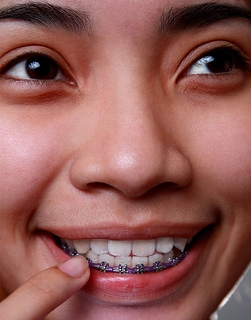September 25th, 2024

In Hollywood, a world where image and beauty is just about everything, many celebrities take the time to fix flaws in their appearance that make them feel uncomfortable. One of those such celebrities is soul surfer Bethany Hamilton, who chose to straighten her teeth using Damon Smile braces, an orthodontic treatment we proudly offer at Sung Lee Orthodontics that combines patented "tie-less" braces with advanced memory wire.
Hamilton, who overcame an injury from a horrific shark attack to return to professional surfing, chose Damon Smile to perfect her smile. With her choice, she showed children, teens, and adults who are apprehensive about orthodontic treatment that even celebrities get braces.
At age 14, Hamilton began her orthodontic treatment for a severe underbite with significant crowding and a narrow arch. She also had an open bite, which meant there was an open space between her upper and lower teeth when her jaw was closed. These types of cases are typically among the most difficult to treat and often require surgery. Hamilton relied on Damon Smile rather than traditional braces for her treatment.
If you have been thinking about an orthodontic procedure, come see us at Sung Lee Orthodontics for an assessment to see if Damon Smile is right for you! Give us a call today at our convenient Puyallup, WA office!
September 25th, 2024

Dr. Sung Lee and our team know it is natural for you to feel some concern when you need to wear any type of dental device to correct a problem with your teeth. Both braces and Invisalign can produce good results in giving you the smile you’ve always wanted. Both methods can straighten your teeth and alleviate such issues as crowding, spacing, cross bite, overbite, and underbite. Both methods of treatment have a similar cost.
You can take a cross-country road trip in a ten-year-old economy car or you can make the trip in a brand-new luxury sedan. Both will get you to your destination, but you will be far more comfortable traveling in the luxury sedan. Similarly, your journey to a great smile is much more comfortable and convenient with Invisalign as opposed to braces.
Comfort
Some of the discomfort you may experience with braces is greatly reduced with Invisalign. Because Invisalign is custom-fit to your mouth and made of plastic, you will feel less pain, irritation, and soreness. Unlike braces, there are no food restrictions; you can eat anything that is on your diet.
Brushing and flossing
Of course you will want to brush and floss your teeth to prevent plaque buildup, tooth discoloration, and dental decay. If you wear braces, these simple tasks can become quite a challenge. Invisalign aligners are very easy to remove and replace, so you can brush or floss like normal without having to work your way around any metallic framework covering your teeth.
Appearance
You do not have to be embarrassed to show your teeth when you are using the Invisalign system. Since the aligners are practically invisible, no one will even notice you are wearing them! Whether you are a teenager or an older adult, you can live your life normally.
If you want to learn more about Invisalign, or are wondering what your treatment options are at Sung Lee Orthodontics, feel free to give us a call at our convenient Puyallup, WA office!
September 24th, 2024

Did you know that even in ancient times, people wanted to improve the look and function of their smiles? Sung Lee Orthodontics thinks of modern orthodontic appliances as sleek, efficient technology, but this was not always so! Take a look at the highlights in the evolution of braces.
Ancient Times: From Greece to Rome
- According to The Angle Orthodontist, Aristotle and Hippocrates first thought about methods for straightening teeth between 400 and 300 BC.
- The Etruscans, in what we now know as Italy, buried their dead with appliances that maintained spaces and prevented collapse of their teeth and jaws during life. Archaeologists have discovered mummified remains in various locations that have metal bands wrapped around the teeth.
- A Roman tomb has also been discovered in which the teeth were bound with gold wire, including documentation on the wire’s use as a dental device.
18th Century: A French Development
- The French dentist Pierre Fauchard is acknowledged as the father of modern dentistry. In 1728 he published a book that described various methods for straightening teeth. Fauchard also used a device known as a “blandeau” to widen the upper palate.
- Louis Bourdet was another French dentist who published a book in 1754 that discussed tooth alignment. Bourdet further refined the blandeau and was the first dentist to extract bicuspids, or the premolar teeth between canines and molars, for the purpose of reducing tooth crowding.
19th Century: Orthodontics Defined
- Orthodontics started to become a separate dental specialty during the early 19th century. The first wire crib was used in 1819, marking the beginning of modern orthodontics.
- During this period, gold, platinum, silver, steel, gum rubber, vulcanite, and occasionally wood, ivory, zinc, and copper were used — as was brass in the form of loops, hooks, spurs, and ligatures.
- Edward Maynard first used gum elastics in 1843 and E. J. Tucker began making rubber bands for braces in 1850.
- Norman W. Kingsley published the first paper on modern orthodontics in 1858 and J. N. Farrar was the first dentist to recommend the use of force over timed intervals to straighten teeth.
20th Century: New Materials Abound
- Edward Angle developed the first classification systems for malocclusions (misaligned teeth) during the early 20th century in the United States, and it is still in use today. Angle founded the American Society of Orthodontia in 1901, which was renamed the American Association of Orthodontists in the 1930s.
- By the 1960s, gold was universally abandoned in favor of stainless steel.
- Lingual braces were the “invisible” braces of choice until the early 1980s, when tooth-colored aesthetic brackets made from single-crystal sapphire and ceramics became popular
Today
As we arrive in the present, you need only look at your own braces to see how far we’ve come. Your treatment plan was probably created with a 3D digital model, and we’ve likely used a computerized process to customize your archwires. Perhaps you have clear aligners, self-ligating brackets, or highly resilient ceramic brackets with heat-activated wires.
Orthodontics has come a long way from the days of Aristotle, and even the bulky wrap-around braces of just 60 years ago. Regardless of your specific treatment plan, the development of high-tech materials and methods has made it possible for your orthodontic experience to be as effective, efficient, and comfortable as possible. Call our office in Puyallup, WA to schedule your first orthodontic consultation!
September 4th, 2024

It's the end of summer, and fall is just around the corner. Soon the temperatures will cool down, the leaves will start to change, and Dr. Sung Lee and our team at Sung Lee Orthodontics are sure that you’ll soon be thinking about Halloween costumes and Thanksgiving plans in no time. But wait! First, we want to know about your favorite parts of the summer! Did you go on a wonderful family trip? Did you pick up a new hobby? Did you try to spend as much time outside and in the sun as possible?
Share your favorite memories, stories, or photos with us by leaving a comment below or on our Facebook page.




